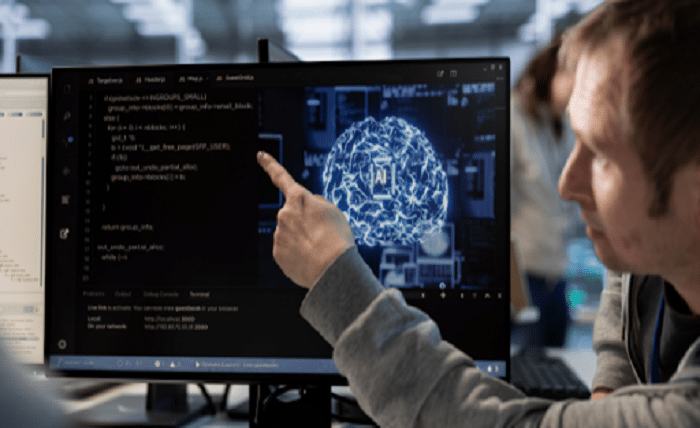AI in Web Development: Automating Coding, UX, and beyond

The way we build websites is changing—and AI is leading the charge. What used to be weeks of back-and-forth between design and development can now be optimized, automated, and in some cases, self-optimizing. We are moving into a time when the tools we use are as intelligent as the people who are designing them.
AI isn’t making things go faster; it’s shifting the focus away from getting the work done to thinking greater about what’s possible.
Let’s break down how AI is revolutionizing the web development future in three general areas: code generation, UX innovation, and intelligent performance.
- Web Page Code Isn’t Manual Anymore. It’s Supported.
The grunt work of web development? That’s what AI is best at. We’re talking faster turnarounds, cleaner base code, and way fewer headaches. The real value of AI in coding is that it speeds up repetitive tasks and allows developers to focus on higher-level functions—like creating unique, scalable solutions.
How it’s happening:
- Smart code assistants like GitHub Copilot suggest whole functions, chunks, or even pages based on a number of lines of input. This means that developers don’t have to bother with the syntax and can rather focus on how to come up with creative features.
- Prompt-based development is where you simply describe in plain language what you require and get a code snippet that will work. For example, if you are building a chatbot, all you need to do is describe the functionalities, and the AI can provide you with a code suggestion to achieve it.
- Low-code sites empower non-devs to launch websites with minimal technical input. These sites recognize user intent and automatically design custom layouts, functionality, and integrations, democratizing the power of web design.
- Real-time error detection catches bugs as you code—not after launch. With AI infused directly into IDEs, devs receive instant feedback on potential problems like syntax errors, inefficient queries, or even security threats.
This isn’t shortcut-taking. This is frictionless so your devs can do their best thinking—and not their fastest typing.
- UX that Learns as It Goes
Designing for static user personas? Please.
AI allows us to design for dynamic, real users whose behavior changes by click. 2025 AI tools are more than just monitoring user behavior—these decide in the moment how the user experience can be improved as individuals use the site.
This is how UX gets intelligent with AI:
- Heatmaps + behavior tracking software show exactly where users are stuck or dropping off. By clickstream analysis and scroll depth, AI can suggest layout changes or initiate content modifications to keep people on board.
- Personalization on the fly presents content, layouts, or calls to action that are tailored to the behavior or context of every visitor. AI is able to predict what a user might be interested in based on browsing history or time spent on certain parts.
- Conversation UIs are more than mere support bots—rather, they’re part of the overall experience, guiding the user, capturing information, and even driving conversions. Take virtual assistants powered by AI that assist the user with navigating multi-step journeys, e.g., buying a flight or solving an issue.
- Accessibility enhancements by AI enable interfaces to adapt for screen readers, voice command, or other modes of input. This enhances the inclusivity of sites and ensures they comply with accessibility standards, while also optimizing them for a larger audience.
AI-driven UX does not just react. It expects and adapts, making every click count and getting users to their destination faster.
- Performance? Automated. Constant. Smart.
A speedy site is a wonderful site but keeping it so used to be a pain. Not anymore with AI website development. AI now monitors and tweaks performance like an automated pit crew. Any measure of a site’s performance, from speed and SEO ranking, can be automated to optimize for a seamless end-user experience and better search visibility.
What it looks like in action:
- Dynamic image compression by user device or internet bandwidth. AI-powered applications can compress images dynamically, so they look crisp on high-resolution displays but still load fast on slow networks.
- Real-time SEO audits that suggest keyword optimizations, link architecture, and even competitor metrics. Tools like Frase use AI to scan top-ranking pages in your space and offer actionable SEO suggestions for your website.
- Predictive load testing simulates spikes in users and detects vulnerable points before they cause downtime. AI-based testing environments can foresee where issues will occur when traffic is heavy and suggest solutions to prevent bottlenecks.
- Smart deployment pipelines push updates based on past performance or roll back if a bug is discovered post-launch. This is triggered by machine learning models that observe how new features are performing in real-world scenarios, allowing constant optimization.
Forget check-ups—your site is learning every moment how to be faster, leaner, and more findable, without any human intervention.
Artificial Intelligence (AI): A Collaborator, Not a Competition
Let’s call a spade a spade: AI ain’t coming to steal your job. It’s coming to unburden your plate. The smartest teams in 2025 are using AI as an assistant—doing the mundane tasks while the humans focus on high-level thinking, strategy, and solving problems.
The best news about AI for web development? It enhances human capability, not replaces it.
Here’s how it goes down in real life:
- Developers get the first cut of code from AI and subsequently incorporate business logic to create solutions that align with company goals.
- Designers look at AI-powered behavioral insights and then incorporate personality and glamour to user interfaces in a way that makes them interesting and distinctive.
- Product managers use AI-generated data stories to make roadmap decisions, tweaking the user experience and making intentional choices based on real user input.
That is, AI handles the “how”, and you’re free to handle the “why”. The true power of AI in web development is the way that it loads your team’s creativity and ability.
What You Need to Know
- Code isn’t automated, but backed. You do more, better, faster.
- UX is unfolding in real time. AI helps create personalized paths without constant human input.
- SEO and performance are baked in. Optimization happens automatically, not by hand.
- Human imagination still reigns supreme. AI augments, accelerates, and multiplies—it never replaces.
What’s Next?
If your web development process still feels like a relay race, handing over work from one team to the next, it’s time to do things differently. AI gives you the chance to work smarter, not just faster. By automating repetition work and focusing on insights, AI can transform the way you create and build.
At Techved, a website development company, we help businesses embed AI into every layer of digital experience, ideation to interface. Are you ready to scale, personalize, and optimize with the best web development services like never before? We are. Are you ready to build a smarter web page?




